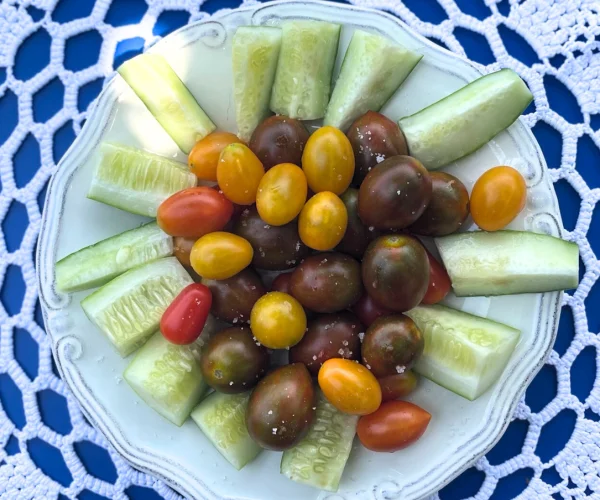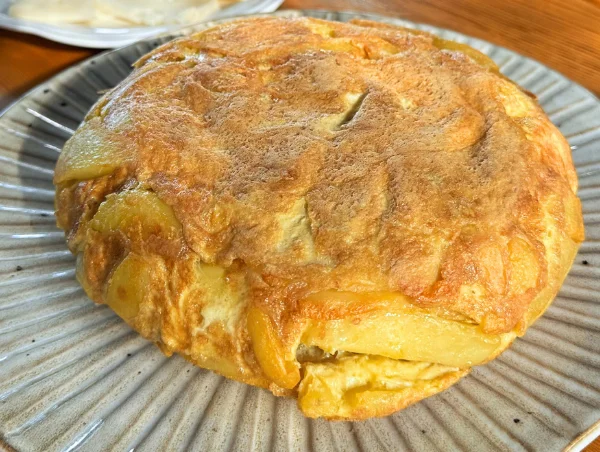According to Taste Atlas and its “Food Experts” reviews, the best dakos in the world can be enjoyed right here at “Peskesi” and we believe good things are meant to be shared!
Nothing describes it better than the phrase “the abundance of simplicity.” This is the Cretan dakos. One of the world’s favorite quick, easy, nutritious, and delicious foods. Its secrets? Truly good ingredients, care, and… it’s not about effort, it’s about doing it right!
Now an iconic dish of modern Cretan cuisine—since tomatoes likely arrived on the island in the late 19th century—dakos is a summer classic, a habit turned into a ritual of love.
Dakos 3-2-1
Three times with olive oil, two with salt, one with oregano.
Ingredients
● 1 dakos or barley rusk
● 1 large juicy tomato, grated or half grated and half finely chopped
● 1 generous tablespoon of galomizithra or xynomizithra (soft Cretan cheese)
● At least 6 tablespoons of extra virgin olive oil
● 1 sprig of oregano, fresh (chopped) or dried, plus extra for serving
● flower of salt
● 2-3 Olives
Instructions
Step 1 – Slightly moisten the dakos, drizzle with 2 tbsp of extra virgin olive oil, and sprinkle with salt.
Step 2 – Spread the tomato on top, drizzle with 2 more tbsp of olive oil, and salt again.
Step 3 – Add the galomizithra and oregano, and finish with 2 more tbsp of olive oil.
Top with olives and enjoy!
What makes the difference:
The rusk
Born out of necessity, twice-baked bread—known as paximadi (rye rask)—helped Cretans (and other Greeks) survive in times of scarcity. Yet it remained a staple in the island’s daily diet, and dakos became a dish for all occasions.
Not every rusk will do. Choose one made with at least 50% barley flour and pure ingredients, with a firm, crunchy texture ideal for soaking up water and tomato juice. Even better: go for a sourdough barley rusk baked in a wood-fired oven for unmatched flavor.
How to moisten it
Dakos rusks only need a little water, don’t rinse them under the tap. Dip the rusk in a bowl of water for one second, then shake off the excess. The more barley it contains, the harder it is, and the more water it needs to soften slightly while staying crunchy. Remember, the tomato juice will also soak into the rusk.
Tomato
Only a well-grown, ripe, juicy tomato will do (dried cultivated tomatoes will make the difference). You can grate half and finely chop the other half for a more textured topping.
Olive oil
The use of extra virgin olive oil in Cretan cuisine is “the law.” For dakos, choose a fruity oil with a balanced bitter and peppery flavor.
Cheese
The best choices are galomizithra from Eastern Crete or xynomizithra from the West. Each creates a slightly different dish, both equally delicious. If Cretan cheeses are not available, use a good quality soft feta.
Olives
Olives are dakos’ natural companion. Choose Cretan “stafidelies” (wrinkled-style) for their deep flavor, or go with Koroneiki or crushed Tsounates olives.
________________________________________
References:
- Giagou, V., Dimitriou, D., Lazarou, C., & Matala, A.L. (2011). The generous face of simplicity: Meal habits and traditional food products of Cyprus. Hellenic Journal of Dietetics & Nutrition, Vol. 2, Issue 2, pp. 95–102.
- Karatzas, I. (2004). The history of agriculture in Crete. Cultural Foundation of the Bank of Cyprus.
- Stavroulakis, S. (1993). The Cretan diet and the traditional agriculture of Crete. Heraklion: Mediterranean Agronomic Institute of Chania.

